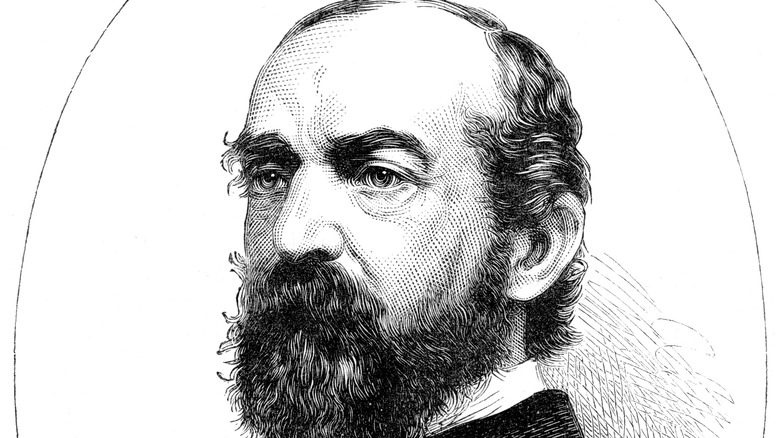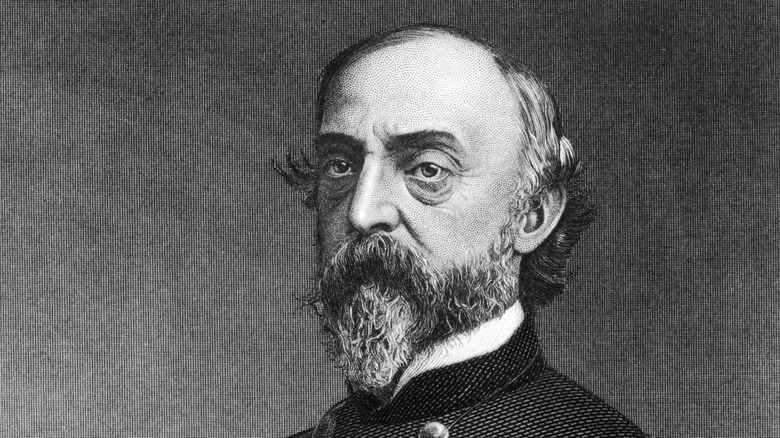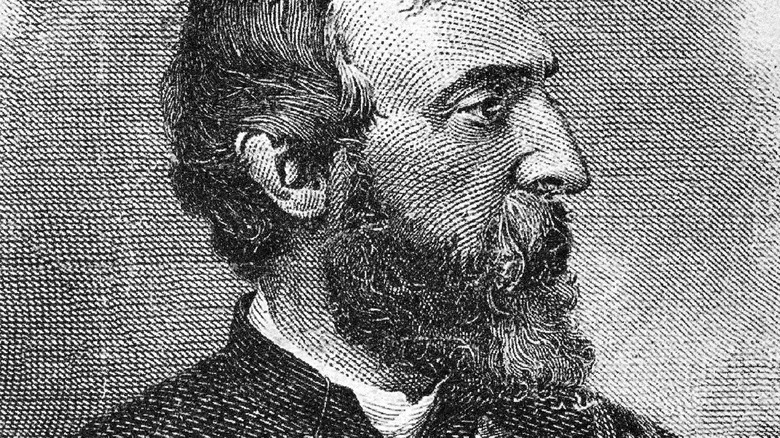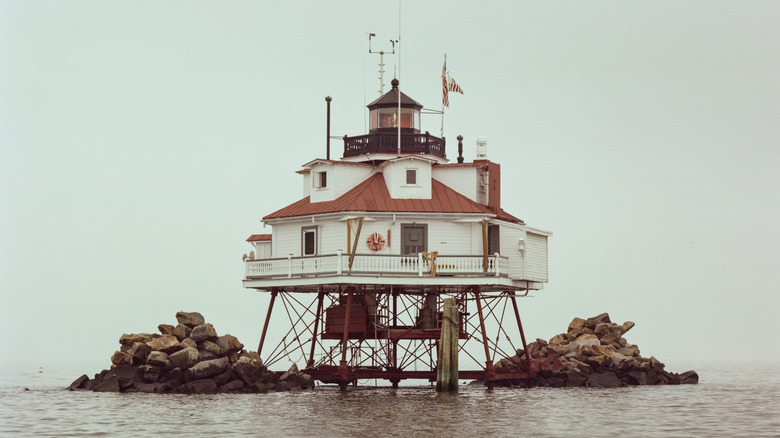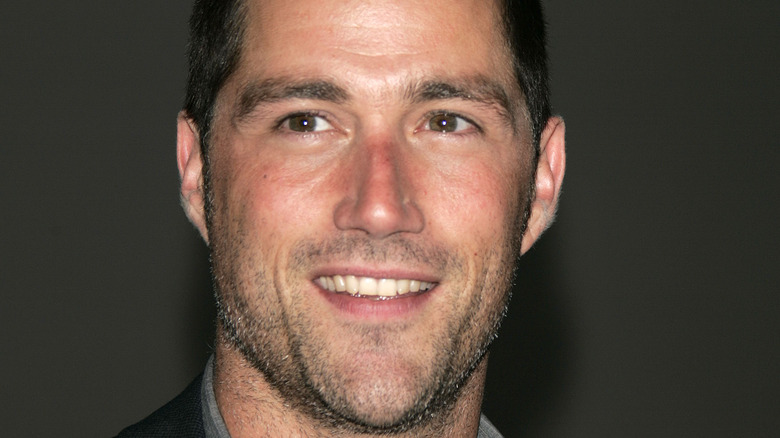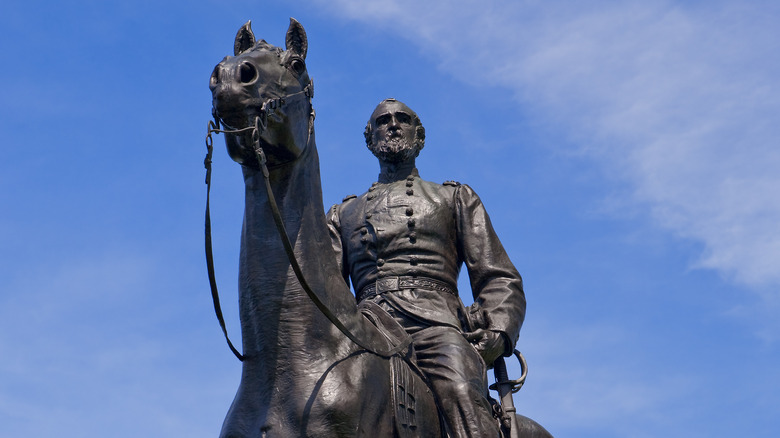The Untold Truth Of The Real General George Meade
"Behind Us, a Cliff," the second episode of the highly-anticipated Paramount+ series "1883" featured a surprise cameo from Tom Hanks in the role of General George Meade, a true-to-history Civil War general best known for defeating Confederate General Robert E. Lee at the Battle of Gettysburg in the American Civil War, per History. Hanks said little in the role, but his brief and enigmatic appearance in a flashback raises many questions about this important figure in American history, regarding his military service, his life after the war, and his legacy (via Pop Culture).
Prior to enlisting in the army a second time following brief stints in the service as a young man, Meade worked as a civil engineer for the railroad and the U.S. War Department. He reenlisted in the army in 1842, serving as a junior officer in the Mexican-American War and working for the Army Corps of Topographical Engineers all throughout the 1850s. By 1863, the Civil War was raging, and as a commander, Meade made strong showings in several clashes, including the Second Battle of Bull Run, the Battle of Antietam, and the Battle of Fredericksburg, among many others. General Meade found himself near Gettysburg, Pennsylvania, serving as a major general of volunteers under General John Hooker.
He had only just been appointed Major General
The 1863 Battle of Gettysburg was one of the bloodiest and most decisive victories for the Union Army in the American Civil War. Three days before the battle began, General John Hooker resigned his post, per History. This means George Meade had only been appointed Major General by President Abraham Lincoln a few days prior to leading the Union Army against the Confederates, according to Britannica. This new post did not begin auspiciously for the freshly-minted military leader.
On the first day of fighting at Gettysburg, Meade's troops suffered heavy casualties. In response, Meade's forces retreated to a defensive position, holding that ground under sustained assault from the Confederates. Meade's forces then scored massive Confederate casualties in what later became known as "Pickett's Charge." Following the melee, the Confederate Army retreated. Despite this success, and even though Meade retained control of the Army of the Potomac for the remainder of the year, he would be heavily criticized for allowing Lee's troops to escape. These were only verbal assaults in the media and from high-ranking government officials. General Meade had endured wounds in the past, however, and managed to go on fighting — just like he did following the metaphorical wounds he received after the Battle of Gettysburg.
Shot three times, he went back for more
One year prior to the Gettysburg, in 1862, George Meade was serving as a brigadier general, near Glendale, Virginia, per History. According to the American Battlefield Trust, the Union V Corps had been handily beaten back by Confederate forces, retreating to the James River to lick their wounds in safety. At this point, the Confederates engaged Union troops, including Meade, at the crossroads near Glendale, under Major Generals James Longstreet and A. P. Hill.
It was during what later became known as Battle of Glendale, part of the Seven Days Battles, that George Meade sustained his most life-threatening injuries in combat. He was shot three times — in the arm, back, and side, according to American History Central. One bullet is said to have injured his liver, per Civil War Talk. It would be complications from these war wounds that would contribute to George Meade's death in 1872 (via History). Somewhat miraculously, George Meade went on to fight at both the Battle of Antietam and the Battle of Fredericksburg just a matter of months after recovering from the wounds he received at Glendale.
He also designed and built lighthouses
Not all of George Meade's accomplishments are limited to the field of battle. Prior to the Civil War, George Meade designed several lighthouses for the Army Corps of Topographical Engineers using an innovative screw-pile design (pictured above) in the 1840s and '50s. Many of Meade's lighthouses stand to this very day, especially around the Florida Reefs and the Delaware Bay, according to the George Meade Society. Because of this, Meade sustained a lifelong interest in phonology, the study of lighthouses and signal lights.
In addition to designing lighthouses in the Florida Reef, Meade also played an important role in exploring and charting the area. One of Meade's most well-known lighthouses is the Carysfort Lighthouse. The Carysfort project was launched by the engineer and lighthouse inspector Isiah P. Lewis. Echoing Gettysburg, Lewis quit before the project was complete and Meade was brought in to finish the work. Other advances related to lighthouses that Meade was responsible for include the development of a five-wick, hydraulic lamp, replacing the difficult-to-use French lamps which were common in American lighthouses at the time, per the George Meade Society.
Famous people are related to Meade
Tom Hanks is the only well-known actor linked to General George Meade. Matthew Fox (pictured above) — star of the hit TV hit series "Lost," and "Party of Five," and films like "World War Z," among others — is reportedly the great-great-great grandson of the Civil War General, according to The Things. Is it possible to compare a 19th-century picture of Meade side-by-side with a modern-day photo of Fox and see a family resemblance? We'll leave that up to you to decide.
On the subject of George Meade's family, he married Margaretta Sergeant in 1840, and the couple would go on to have seven children together, per History. For this reason, there are many more descendants of the famous general among us today. In addition to Fox, Meade's great-great grandson is actor and film producer George Meade Easby, who is said to have inherited from his ancestor several valuable items once owned by Napoleon Bonaparte, according to Military History, and Happy Rockefeller, the second wife of Nelson Rockefeller, per The New York Times.
He's worth a thousand dollars
In addition to a number of statues and other kinds of memorials commemorating the service of General George Meade, his image was also on an early version of the $1,000 bill, issued from 1862 to 1863 (via Barron's). President Grover Cleveland's face adorns modern $1,000 notes today (per Carnation–Inc.). The Meade notes are also called "The Grand Watermelon" for the extra-rounded typeface in the zeroes on the back of the currency, resembling watermelons.
Also notable, as recently as 2018, a "Grand Watermelon" note sold for more than $2 million, according to Barron's. Prior to that, an example became the first paper currency to break the $1 million mark at auction.
The Paramount+ series "1883," a prequel to the hit show "Yellowstone," promises to be a richly-textured and historically accurate, though fictional, piece of storytelling. Understanding the untold truth of General George Meade adds context and a better understanding of the circumstances surrounding this engrossing portrayal of American history.
